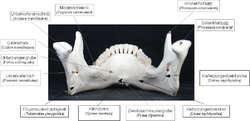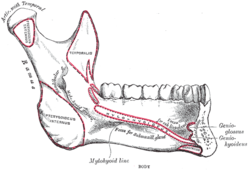- Mental spine
-
Mental spine 
The posterior aspect of the mandible showing the mental spine. 
A medial view of the mandible showing the attachments of geniohyoid and genioglossus. Latin spinae mentalis Gray's subject #44 172 A mental spine is a small projection of bone on the posterior aspect of the mandible (jaw bone) in the midline. There are usually 4 mental spines: 2 superior and 2 inferior. Collectively they are also known as the genial tubercle[1], genial apophysis and the Latin name spinae mentalis. The inferior mental spines are the points of origin of the geniohyoid muscle[2], one of the suprahyoid muscles and the superior mental spines are the origin of the genioglossus muscle, one of the muscles of the tongue.
References
- ^ "Genial tubercle." The American Heritage Stedman's Medical Dictionary. Houghton Mifflin Company, 2002. http://www.answers.com/topic/mental-spine Accessed: 22 Oct. 2007.
- ^ "Genial tubercle." Mosby's Dental Dictionary. Elsevier, Inc., 2004. http://www.answers.com/topic/mental-spine Accessed: 22 Oct. 2007.
Bones of head and neck: the facial skeleton of the skull (TA A02.1.08–15, GA 2.156–177) Maxilla SurfacesProcessesOtherZygomatic Palatine FossaePlatesProcessesMandible external surface (Symphysis menti, Lingual foramen, Mental protuberance, Mental foramen, Mandibular incisive canal) · internal surface (Mental spine, Mylohyoid line, Sublingual fovea, Submandibular fovea) · Alveolar part of mandibleMinor/
noseNasal bone: Internasal suture · Nasal foramina
Inferior nasal concha: Ethmoidal process · Maxillary process
Vomer: Vomer anterior · Synostosis vomerina · Vomer posterior (Wing)
Lacrimal: Posterior lacrimal crest · Lacrimal groove · Lacrimal hamulusCategories:- Bones of the head and neck
Wikimedia Foundation. 2010.
